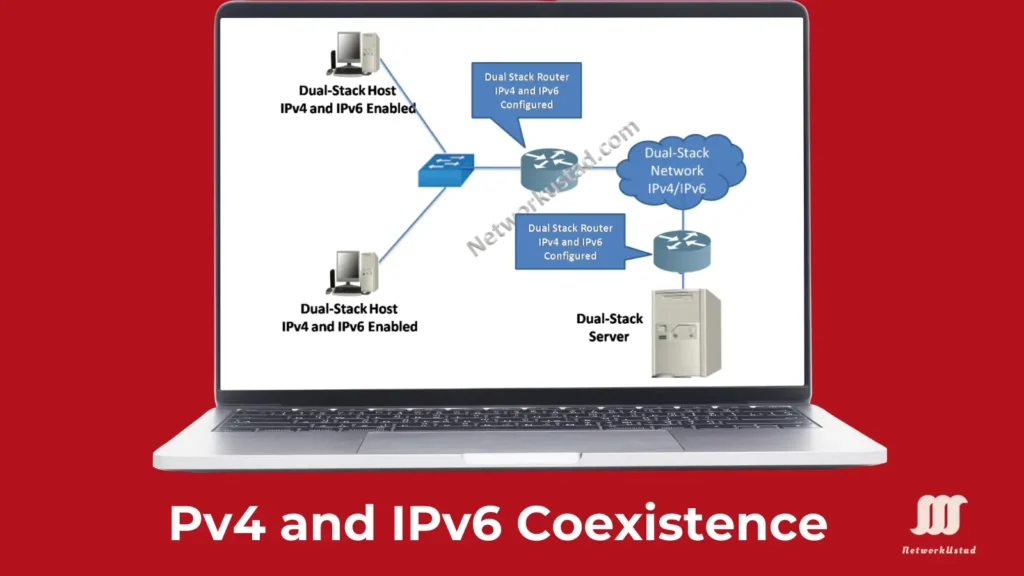Comprehensive Guide to IPv4 and IPv6 Coexistence: Strategies, Challenges, and Future Outlook
The limited IPv4 address space is one of the main issues for network administrators, IT professionals, and businesses worldwide. So, the time frame for IPv4 to IPv6 transition is important. The main problem in the transition from IPv4 to IPv6 is the size of the Internet. The one-time migration from IPv4 to IPv6 addresses is impossible because some IPv4 addresses may never change.
Therefore, IPv4 and IPv6 coexistence on the internet is necessary. The IPv6 addressing system was launched 20 years ago, but it still needs several years for transition. I am writing this article on the 6th of April 2025, but the data is available on Google from 15 Mar 2025. According to the data from Google, 47.92% translation from IPv4 to IPv6 is completed. The Screenshot for the data provided by Google is attached below.
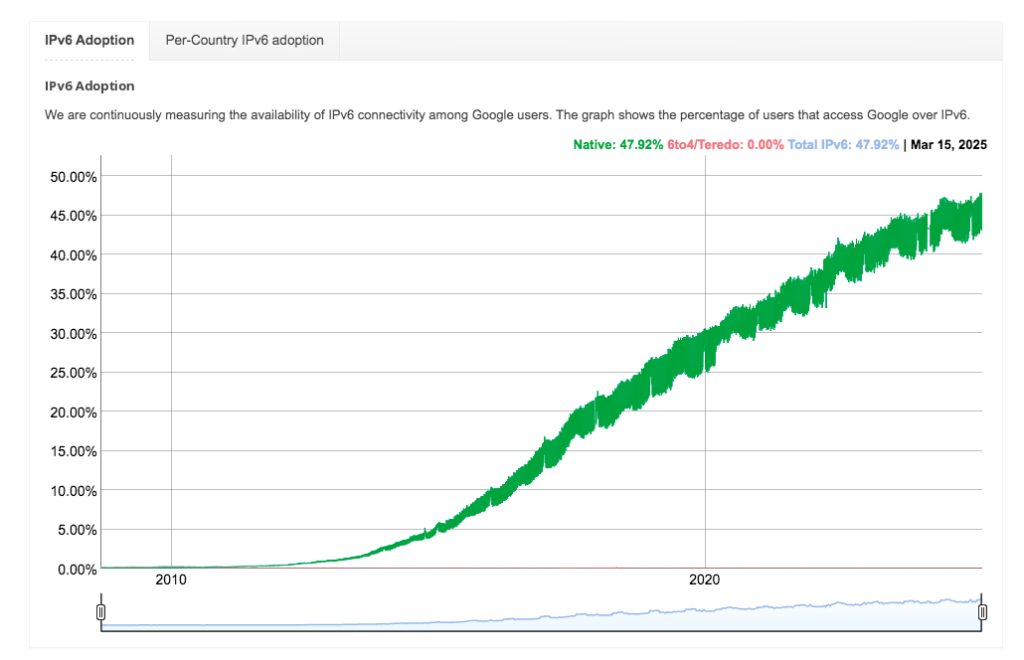
The IETF also created several protocols and tools to help network administrators migrate their networks to IPv6. The transition from IPv4 to IPv6 is divided into three categories. Dual stack, where your network hardware runs IPv4 and IPv6 simultaneously. Next is the “tunnel” method, where we take IPv6 packets and encapsulate them into IPv4 packets. The last is Network Address Translation-Protocol Translation (NAT-PT), also known as RFC-2766. NAT-PT works like the name says: software or a device translates IPv6 packets into IPv4 packets. The following are the details of these methods.
Introduction to IPv4 and IPv6 Coexistence
IPv4 has been the backbone of the internet for many years. Due to the current rapid growth of devices on the internet, the address space of unique addresses is nearing exhaustion. To solve this issue, a 128-bit IPv6 addressing scheme was developed to accommodate trillions of devices. However, the main issue is the transition from IPv4 to IPv6, which is not instantly possible due to many reasons. Therefore, both protocols must coexist to ensure compatibility and continuity.
The coexistence of both addressing schemes is not only a technical challenge but also a strategic necessity. As of 2025, global IPv6 adoption stands at approximately 51% in the U.S. and 6% in China, according to Google Statistic. This slow shift means that networks must support both protocols together, ensuring that the old IPv4 system can communicate with modern IPv6-enabled devices. In this article, we will discuss all methods of IPv4 and IPv6 coexistence, compare them with insights from top Google search results, and provide actionable strategies for network professionals to optimize their infrastructure.
Foundational Concepts: Dual Stack and Tunneling
Dual Stack
In dual-stack networking, all network devices, including routers, servers, and firewalls, will be configured for IPv4 and IPv6 capabilities. The whole network must understand both IP versions of packets and allow the processing of IPv4 and IPv6 data traffic simultaneously. Dual stack allows IPv4 and IPv6 to coexist on the same network segment. Dual-stack devices run both IPv4 and IPv6 protocol stacks simultaneously. The Figure below illustrates the Dual-Stack process.
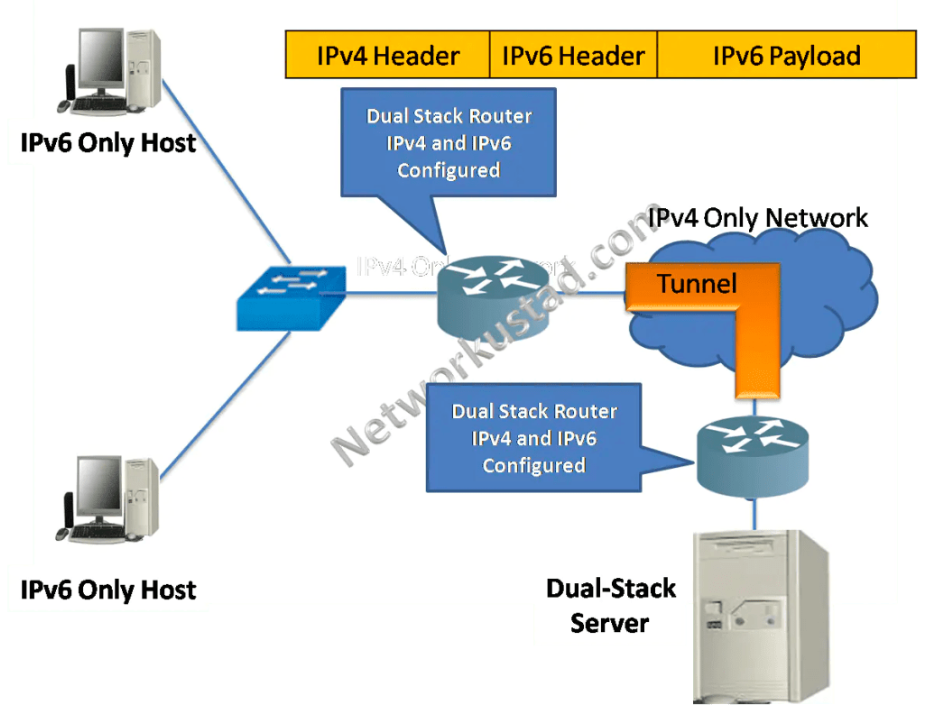
When a node is configured for a dual-stack network, it is configured to prefer IPv6 over IPv4 traffic. If the traffic it receives is solely IPv4, then the dual stack node is capable of processing it as well. It is one of several solutions for migrating from IPv4 to IPv6, but it is also one of the most expensive.
Tunneling
Tunnelling is another method of IPv4 and IPv6 co-existence. In tunnelling, an IPv6 packet is transported over an IPv4 network. The dual stack routers encapsulate the IPv6 packet inside the IPv4 packet, just like the router encapsulates other data into IPv4 packets. We can communicate using tunnelling with isolated IPv6 networks without upgrading the IPv4 infrastructure. We only required tunnel configuration between border routers or between a border router and a host; however, the critical point is that both tunnel endpoints must support IPv4 and IPv6 protocol stacks. We can configure tunnelling either manually or dynamically. The essential methods for tunnelling are listed below. The figure below illustrates tunnelling:-
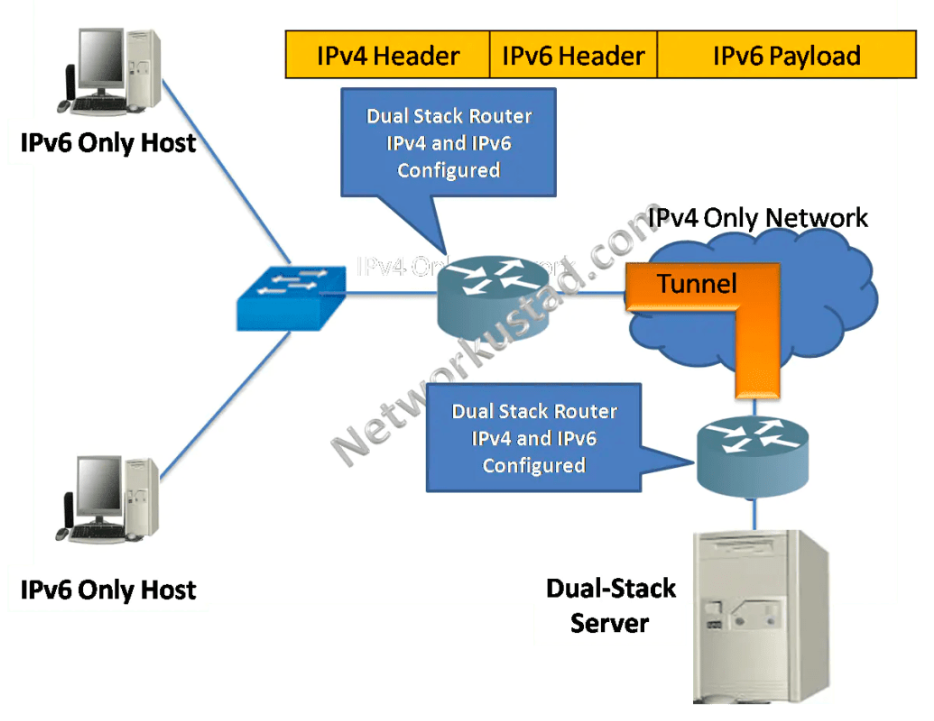
Techniques like 6to4, Teredo, and ISATAP are commonly used, each with specific use cases. For example, 6to4 tunneling automatically assigns IPv6 addresses based on the public IPv4 address, making it suitable for edge networks. However, ZDNET highlights security risks, such as potential denial-of-service (DoS) attacks, due to the encapsulation process. This method is ideal for temporary solutions but may not scale for long-term IPv4 and IPv6 coexistence.
IPv4-compatible
In the IPv4-compatible tunnel method, the tunnel destination is automatically determined by the IPv4 address in the low-order 32 bits of IPv4-compatible IPv6 addresses. The host or router at the source and destination ends of an IPv4-compatible tunnel must support both the IPv4 and IPv6 protocol stacks.
Generic routing encapsulation (GRE)
Generic routing encapsulation (GRE) encapsulates packets and sends them to a device that de-encapsulates them and routes them to the final destination. GRE tunnels allow routing protocols such as RIP and OSPF to forward data packets from one switch to another across the Internet. In addition, GRE tunnels also encapsulate multicast data streams for transmission over the Internet.
6to4
It is a method to connect IPv6 hosts or IPv6 networks over an IPv4 backbone. 6to4 required relay routers to forward encapsulated IPv6 packets over IPv4 links instead of explicit tunnel set-up. It uses unicast to create point-to-point links over the IPv4 backbone for transmission. The host using 6to4 can communicate with another 6to4 host as well as a host of native IPv6 connections. However, 6to4 tunneling has reliability issues, with high failure rates due to firewall blocks, making it less suitable for production environments.
Intrasite Automatic Tunnel Addressing Protocol (ISATAP)
Intrasite Automatic Tunnel Addressing Protocol (ISATAP) can encapsulate and transmit IPv6 packets over IPv4 networks or IPv4 packets over IPv4 networks. It provides automatic encapsulation by using a virtual IPv6 overlay on top of an IPv4 network using IPv4-configured routers.
Translation
The figure below illustrates the translation method. Network Address Translation 64 (NAT64) allows IPv6-enabled devices to communicate with IPv4-enabled devices using a translation technique similar to NAT for IPv4. An IPv6 packet is translated to an IPv4 packet and vice versa. It allows IPv6-only clients to communicate with IPv4 servers using unicast UDP, TCP, or ICMP. One or more public IPv4 addresses assigned to a NAT64 translator are shared among several IPv6-only clients.
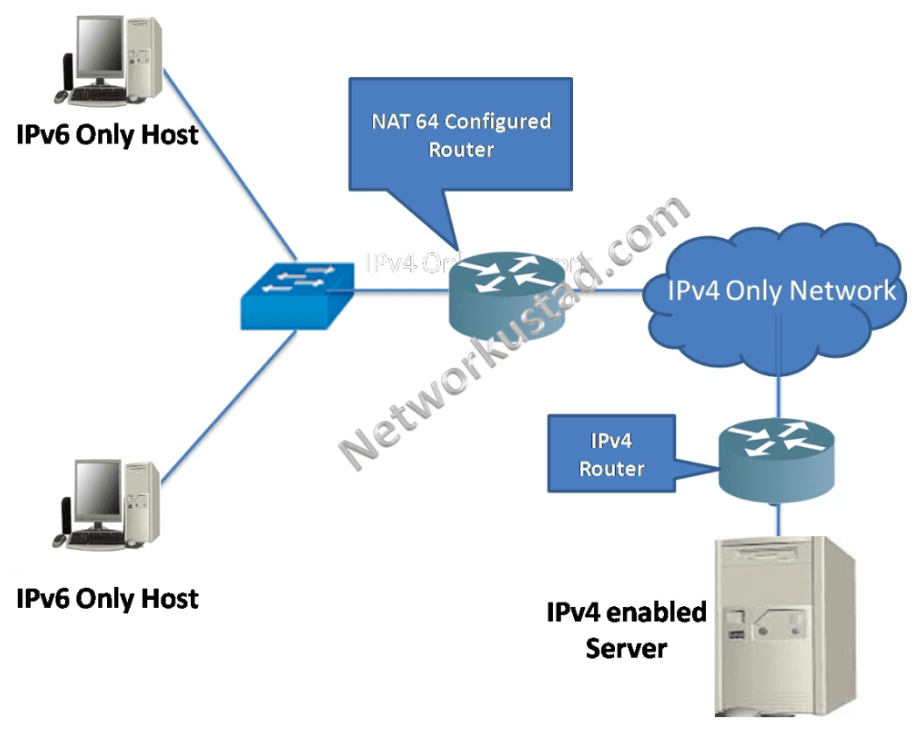
Additional IPv4 and IPv6 Coexistence Methods: NAT-PT, DS-ALG, and MPLS Tunnels
Network Address Translation-Protocol Translation (NAT-PT), Dual Stack Application Level Gateways (DS-ALG), and Multi-Protocol Label Switching (MPLS) tunnels are the additional method to coexist both IPv4 and IPv6.
- NAT-PT: This method translates IPv6 packets to IPv4 and vice versa, enabling communication between isolated protocol domains. While effective for small-scale networks, it faces scalability issues and is deprecated in modern standards due to complexity.
- DS-ALG: Dual Stack application-level gateways facilitate application-layer translation, ensuring compatibility for applications that may not natively support both protocols. This is particularly useful for legacy applications.
MPLS Tunnels: MPLS provides a label-switching mechanism to encapsulate both IPv4 and IPv6 traffic, offering cost savings without core network upgrades.
FAQs
Dual-stack implementation allows devices to support both IPv4 and IPv6 protocols simultaneously, ensuring seamless communication across mixed networks.
